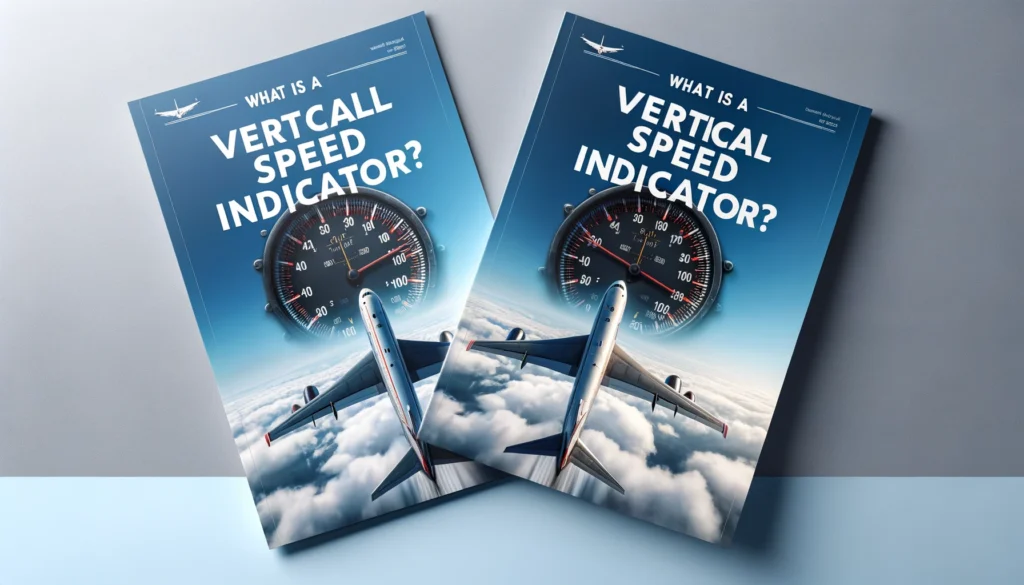Flying is a complex process that involves exploring the complexities of nature and using advanced equipment to keep everyone safe. Pilots got access to various tools to monitor and manage the plane’s speed, altitude, and direction while being ready to respond quickly to any upcoming unexpected situations. Despite all the challenges, flying remains a convenient and efficient way to Travel. Among them are vertical speed indicators (VSI), which are significant in monitoring and focusing on an aircraft’s vertical velocity.
That, nevertheless, does not imply equality among all VSIs. Here, we will analyze the ordinary Standard Vertical Speed Indicators by differentiating features and operating principles and their advanced counterpart, the Instantaneous Vertical Speed Indicator(IVSI), ranked higher on the list.
What is a Vertical Speed Indicator?

Vertical Speed Indicator VSI is one of the most essential cockpit instruments, and it is the pilot’s window into the aircraft’s vertical motion. Flight efficiency and altitude management depend on data obtained from VSI.
Here’s an analysis of its effectiveness and functionality:
- Essential for Flight Safety and Efficiency:
The VSI indicates real-time data on whether the aircraft is climbing up or dissenting down or whether the flight is at its level position. Such knowledge is essential for adhering to the desired flight levels, achieving passenger comfort, and saving fuel.
- Unit of Measurement:
Generally, the VSI displays the rate of climb or descent in terms of feet per minute (fpm) or meters per second, depending on the most regional preferences of either it or the aircraft’s origin.
- Crucial for All Flight Phases:
Moreover, the VSI is essential during the takeoff, cruising, and landing stages of flight. It enables the pilot to take necessary actions to maintain altitude, respond to air traffic control instructions, and avoid dangerous conditions.
How Does a Vertical Speed Indicator Work?

The knowledge about the VSI vectors and their physics explains how intricate aviation technology is. VSI operates on a pressure differences system, but its accuracy and utility have been particularly enhanced with the dawn of digital technology:
- Pressure Differential Mechanism:
In primary, it determines the pressure variations caused by the flight outside the aircraft with constant pressure inside the pressurized plane cabin. With the increase in altitude or when the aircraft is descending, the pressure and the volume of the capsule get affected. The data from the sensors then get arranged into a vertical speed reading via this process.
- Analog vs. Digital:
Typical VSIs run on a mechanical setup to ensure the needle moves in the right direction while climbing or descending. Modern-day aircraft have electronic flight instruments within the Electronic Flight Instrument System (EFIS) that use advanced sensors and algorithms to calculate vertical speed compared to old times to offer more accuracy with instant readings.
- Enhanced Features for Modern Aviation:
Digital vertical speed indicators (DVSIs) are most instantaneous in revealing aircraft height information and the state of the aircraft’s vertical motion, whether accelerating or decelerating. These predictive insights help pilots create a more secure, smoother, and comfortable environment.
Increasing Passenger Security and Improving Flight Operations
Understanding how the VSI and IVSI differ is more than an academic exercise; it’s the foundation of ensuring flight safety, superior performance, and proficient pilots. Pilots, therefore, become more skilled if they know the purpose of the tools and can, hence, choose the ones that better match their particular flying conditions.
- Traditional VSI:
An enduring friend for private planes – easy to operate, yet dependable. Traditional VSI proves its worth in carrying out a function where the climb and descent of altitudes are handled gently. Thus, the vertical movement of the pilot becomes average and uniform.
- Instantaneous VSI (IVSI):
IVSI is the advanced type of traditional VSI invented for high-performance aircraft pilots or those aspiring to master advanced maneuvering skills. Its ability to stream data in real-time is one of the most important reasons why this system can get replaced; it is utilized for operations that demand a quick response system, with few seconds to respond and in which decisions can be made without caution.
The Importance of Maintenance for Accurate Vertical Speed Indicators Readings

Both types of VSI are considered the most significant aircraft pitot-static systems for any aircraft landing purposes. System maintenance is necessary for the accuracy and reliability of VSI readings.
- Pitot-Static System Care:
The routinely conducted inspections and proper maintenance ensure the pilot & aircraft safety, as during landing, a sound & accurate system is essential for getting the correct answers dependent on the VSI readings.
- Troubleshooting and Calibration:
Regular calibration of VSIs guarantees their reliability and accuracy. The pilots and technicians must be alert to any signs of inconsistency in the readings, which could likely represent pitot-static system failure or instrument malfunction.
Choosing the Right Tool for Each Flight:
Deciding on the most optimal system between a vertical stabilizer installed conventionally or omnidirectionally is a function of the aircraft’s performance and the pilot’s and mission’s demands. ‘Normal’ flight conditions of student pilots and private pilots who fly small aircraft can benefit from the ‘classic version’ simplicity and effectiveness of altitude indicators.
As distinct, the VSI is the most indispensable gadget in the cockpit of a high-power jet or for pilots, especially during aerobatic flying or flight approaches under challenging weather conditions.
Finally, it does not matter if the designated instruments are the steady hand of the conventional VSI or the fast response of the IVSI; these instruments are essential since they are great tools that pilots use to maintain awareness of the attitude and ensure that their flights are safe and adequately controlled. By discovering their disparities and categories, a pilot expands his arsenal of tools and becomes aware that the aviation environment never ceases to evolve and that safety and precision rule the sky.
The “Vertical Speed Indicators” and “Instantaneous Vertical Speed Indicators” Comparison: VSI vs. IVSI
The selection between the old typical Vertical Speed Indicator (VSI) and the new Instantaneous Vertical Speed Indicator (IVSI) reflects the advancement of avionic technologies. It shows these instruments’ additional features for different types of flying.
The mechanical simplicity of the traditional VSI gives it reliability and ease of operation, which makes it an excellent tool for general aviation and training purposes.
Unlike traditional standoff instruments, the IVSI, in digital avionics, provides timely vertical speed to control feedback through advanced sensors and algorithms. This distinction between these two “VSI & IVSI” underscores a broader narrative in aviation: the mix between long-proven methodologies and innovative technologies results in pilot proficiency, flight safety, and operational efficiency.
In the process of flying, the pilot’s reactions to the settings and features of the instrument become a critical part of flight management. In other words, it doesn’t matter whether you are getting used to the delayed information from the VSI or the exact signal from the IVSI; each instrument presents a unique learning curve and situation awareness liability. The operational considerations, safety issues, and maintenance aspects of these two types of vertical speed indicators bring us to the dialogue that goes on quite often between tradition and technology in aviation, showcasing the necessity of a proper instrument selection for the task at hand.
Operational Insights of Vertical Speed Indicators: Traditional VSI vs. IVSI
| Aspect | Traditional VSI | Instantaneous VSI (IVSI) |
| Technology Base: | Primarily mechanical, relying upon changes in air pressure. | Most Advanced digital technology, incorporating sensors and real-time data processing. |
| Ideal Use Case: | They are suited for general aviation and training aircraft where immediate changes in vertical speed are less critical. | Best for high-performance and commercial aircraft where real-time vertical speed data is crucial for safety and performance. |
| Learning Curve: | It provides a Lower learning curve, with a pilot interpreting averaged data over time. | Higher learning curve due to the immediacy of data, requiring quick interpretation and response. |
| Cost & Maintenance: | Generally, it has lower cost and more straightforward maintenance due to its mechanical nature. | Higher initial installation and maintenance cost reflects the advanced technology and electronics involved. |
Safety and Efficiency: Role of VSI Readings
| Safety Aspect | Impact of Traditional VSI | Impact of IVSI |
| Flight Stability: | Aids in maintaining stable climbs/descents but may lag behind sudden changes. | Provides immediate feedback on climb/descent rates, enhancing stability in dynamic conditions. |
| Response to Emergency: | A slower response time can delay the pilot’s reaction to unforeseen vertical speed changes. | Instantaneous data allows for quicker decision-making in emergencies. |
| Fuel Efficiency: | Effective for steady-state flight management, contributing to fuel savings over time. | Allows for optimal altitude adjustments in real-time, offering greater fuel efficiency. |
Maintenance Considerations for Vertical Speed Indicators
| Maintenance Factor | Traditional VSI | Instantaneous VSI (IVSI) |
| Calibration Frequency: | Regular calibration is required, though less frequent due to mechanical stability. | It may require more frequent calibration checks due to complex electronics and sensors. |
| Common Issues: | Clogging of static ports, diaphragm leaks, or wear. | Sensor malfunctions, software glitches, or electronic failures. |
| Troubleshooting: | It often involves mechanical inspection and cleaning. | Typically requires diagnostic software and electronic repair expertise. |
Enhancing Pilot Proficiency with VSIs
| Skill Development | Traditional VSI | Instantaneous VSI (IVSI) |
| Altitude Management: | Teaches pilots to plan and execute gradual altitude changes effectively. | Enhances ability to make precise, real-time altitude adjustments. |
| Instrument Cross-Checking: | Encourages pilots to cross-check with altimeter and airspeed indicator for a comprehensive flight picture. | Calculate rapid integration of VSI data with other cockpit information for dynamic flight management. |
| Situational Awareness: | Builds foundational skills in understanding vertical motion and its impact on flight. | It increases pilots’ ability to assess and react to changing flight dynamics scenarios. |
Unveiling the Vertical Speed Indicator’s Role in Aviation Safety

As the speed of aircraft increases, the challenge of maintaining stability also increases. Vertical Speed Indicators serve as one of the essential tools in ensuring aviation safety.
After discussing all the crucial stuff about the Vertical Speed Indicator (VSI) in the cockpit dashboard, the next topic is the technology, security, and human factors in peering with VSI.
You can also call this section “The Symphony of Flight,” which provides visualization of the ever-delicate flows of power, responsibility, and tools that the crews of planes manage, particularly in their assistance to the general aim of travel safety.
Harmonizing Technology and Technique:
Boeing decided to be the ultimate player in the aviation industry by their approach to the most advanced technologies, ensuring that each instrument the pilot relies on is technologically advanced.
Techniques are so significant that they perfectly manage each phase of flight. The VSI is like the metronome in this orchestration but does not provide the exact rhythm for the brevet in or descent.
It’s not something you eliminate; it’s a matter of doing it at the right pace, with the most minor steps possible, while ensuring you remain alert and safe.
Enhancing Situational Awareness:
The play of flight safety also requires pilot situational awareness as its leading element that synchronizes safety.
Moreover, VSI is a significant pilot’s control-enhancing device, giving in-time information that contributes to a better situational awareness of how the aircraft performs in such an environment.
From Trainee to Experienced Pilots:
The route from an amateur flyer to an expert pilot includes bumps, including the challenge of deciphering and understanding the VSI readings. There are different strategies pilots can adopt to get used to the VSI. Starting from the basic training, where you have to focus on how to get accurate VSI reading and your understanding about it, will good training you’ll have a good grip over it.
As a trainee pilot, you must keep in mind that even though technology has evolved, you must have all the basic knowledge that will enhance your basic aviation skills and also help you in flying small planes or even helpful with commercial ones, as you can’t entirely rely on technology as that will compromise overall safety.
Some Most Common Questions Asked About VSI’s
How does the vertical speed indicator VSI) work?:
The Vertical Speed Indicator (VSI) follows the principle in which the changing rate of atmospheric pressure is measured with the ascent or descent of an aircraft. VSI, instead, conveys the difference between the constant air pressure in the sealed chamber and the surroundings’ atmospheric pressure.
What is the Principle Behind a Vertical Speed Indicator?
The vertical speed indicator follows Bernoulli’s principle, where atmospheric pressure falls, will cause an increase in altitude. A VSI employs this principle through sound bursts, as variations in pressure changes correlate similarly to the vertical velocity of the aircraft. Through a diaphragm that inhabits the instrument and reacts to pressure changes in the static air, the arm of the indicator will either extend or contract with this reading of the current pressure displayed on the meter.
Can a Vertical Speed Indicator Serve as an Altitude Indicator?
Although a helpful device, but still vertical speed indicators still can’t be used as altitude indicators. It has benefits as it helps determine the rate at which an aircraft is either rising or descending but does not directly give the aircraft’s altitude. Pilots should use their altimeter, which statically measures pressure to get altitude, and the VSI for accurate altitude management.
What are the Limitations of Using a Vertical Speed Indicator?
Although Vertical Speed Indicators are a crucial instrument in vertical motion measurement, the instrument is still limited to the lag in response since the changes take place slowly, and the system needs time to balance. This decrease in sensitivity may result in finding the correct readings difficult during high speed or in rough weather conditions. Also, malfunctions like occluded static ports cause precision to fall off. A more significant percentage of aircraft can rely on these instruments, so the pilot must keep in mind their limitations and double-check with the altimeter and airspeed indicator to have an overall idea of the aircraft’s position and viability.
How to Read a Vertical Speed Indicator?
Reading from the VSI is usually taken with the help of a knob, needle placement, and the direction it indicates at which of the 13 sectors it is pointing. If the fulcrum of the needle is above zero, the aircraft will climb at the climbing speed indicated; if below zero, the airplane will go for a descent. The more the needle left to zero, the more per minute the change in the rate will be. The pilots utilize the data provided to them to change the parameters of vertical speed by changing the pitching angle and the power settings.
What Differentiates a Vertical Speed Indicator from an Instantaneous Vertical Speed Indicator?
Unlike the traditional Vertical Speed Indicator Vch, known for plodding and providing average data over time, the Instantaneous Vertical Speed Indicator (IVSI) has a more responsive mechanism in response to current flight updates and provides instant speed data. A VSI offers an average rate of climb or descent, which is adjusted to avoid short-term variations that might upset the stability of the aircraft. An IVSI would, however, provide quick feedback on small vertical speed changes. That data from now is critical. In particular, it enables pilots to have accurate data about the essential flight on-time changing circumstances, to avoid difficulties in complex scenarios -including emergencies. This data also ensures the right approach to the change of altitude.
What is a Cabin Vertical Speed Indicator?
One of the specialties of a cabin vertical speed indicator is to help adjust the rate of pressure change within the aircraft but not specify the aircraft’s climb or speed rate. Pressurization of the cabin must be maintained to achieve the desired results, especially during the take-off and landing stages. Maintaining a controlled, steady rate of pressure change is an indicator to avoid discomfort or health issues that result in rapid altitude changes.
What Causes VSI Indicators to Fluctuate?
Turbulence may disturb the stabilization of atmospheric pressure change around the aircraft, resulting in alternate changes in VSI readings. VSI shows the graph of the plane movements vertically in and out of the global airspace, while during turbulence, these readings have to be calculated with caution.
How Have VSIs Evolved During the Development of Modern Aviation Technology?
The advancements in aviation technology have made Vertical Speed Indicators more and more advanced by adding digital displays and sensors with higher accuracies and faster data processing. These advancements have increased pilot’s ability to make significant corrections, thus making flights secure and efficient.
Future Trends: VSIs And Innovations In Avionics.
Advancements in aviation technology make joining various cockpit technologies like Glass Cockpit Systems and Synthetic Vision possible, ultimately offering exciting possibilities in future aviation.
- Glass Cockpit Integration: Modern aircraft computers combine instrument data with the VSI displays. Such integration fosters a more interactive display of information, thus improving situational awareness and the crew’s performance in the air.
- Synthetic Vision Systems (SVS): Merging Vertical Speed Indicators data with SVS will offer pilots a 3D view of the surroundings and allow them to see obstacles and traffic during the climb and descent phases.
Final Thoughts VSIs:
Whether in the traditional version of VSI or the highly enhanced form of IVSI, the Vertical Speed Indicator is the most essential part of flight instrumentation. The function of the vertical speed indicator in obtaining the correct and timely information during the takeoff of an aircraft is unchallengeable. Throughout future voyages of aerospace, values inherent in the VSI will guide the evolution of new technologies, as safety and top accuracy will always be the first preference in flight operations. The article is about vertical speed indicators and emphasizes their usage & importance in aviation technology that helps pilots achieve accuracy and safety during their flights.

